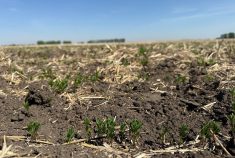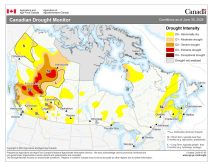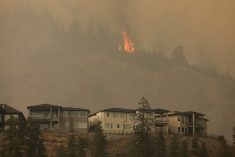There’s no proof the fire that largely destroyed a British Columbia village, damaged a key rail bridge and led to cuts in rail speed limits in high-risk areas was sparked by train traffic, the federal Transportation Safety Board says.
The TSB on Thursday said its investigation, launched in early July, “has not revealed any evidence to link railway operations to the fire” on June 30 that destroyed “the majority of the structures” in downtown Lytton, B.C., about 160 km southwest of Kamloops.
Thus, unless new information turns up to show that a “TSB-reportable” event took place, “no further work will be performed and no TSB investigation report will be produced,” the agency said.
Read Also

India slaps 30 per cent import duty on yellow peas
India has imposed a 30 per cent duty on yellow pea imports with a bill of lading date on or after Nov. 1, 2025.
Apart from traffic halted by damage to Canadian National Railway’s (CN) rail bridge at Lytton, the June 30 fire led to a temporary halt in rail traffic through the area.
Tighter inspections and slower speed limits then followed in July for Class 1 railways’ trains rolling through any areas in Canada deemed to be at “extreme” fire risk.
Those rules — which apply to both CN and Canadian Pacific Railway (CP) — were put in place in July by order of federal Transport Minister Omar Alghabra, and remain in place until the end of this month.
According to the TSB’s report Thursday, the fire in the late afternoon of June 30 was first reported near Mile 98.14 of CN’s Ashcroft subdivision, just west of Lytton, and “grew rapidly due to the extreme hot and dry conditions combined with high-velocity winds.”
The last train through that area passed by about 18 minutes before the fire was reported — a loaded CP coal train of 157 cars, operated by a CN crew, as per a “directional running agreement” between the two railways — travelling at about 40 km/h with “low to moderate throttle,” the TSB said.
The TSB sent its investigator to the area on July 9, based on information from RCMP and B.C. Wildfire Service (BCWS) — and also “in light of the presence of rolling stock in the immediate vicinity of the fire within minutes of the fire first being reported.”
However, the agency said, its inspection of the off-loaded train in Burnaby found no signs of “hot bearings, burnt brake heads, built-up tread (or) other potential fire-creating causes.”
The TSB said it also confirmed with CN and CP that no rail grinding activities or other track work had taken place in the area that day or in the days before the June 30 fire.
Also, “no anomalies were observed or reported” from the TSB’s interviews with rail workers and maintenance staff in the area, nor in any of the video or data from recorders on the lead and tail-end locomotives.
All three locomotives in the train were also subjected to stationary load testing, in which the diesel engines are cycled up to maximum operating r.p.m., and no sparking was seen from any of the locomotives. The locomotives’ exhaust stacks were also found to be “clear of carbon buildup.”
The BCWS had “expressed interest” in samples of a “black, carbonaceous coal-like substance” found on the west side of the track near Mile 98.14 as a “possible source of ignition” and ran a lab analysis of it, the TSB said.
The TSB also collected samples of the substance and ran its own lab analysis comparing it to samples gathered from a locomotive exhaust stack and a rail grinder vehicle. Spectral results found the three analyzed samples “have little in common.”
With no link found between railway operations and the fire, “further effort (by the TSB) is not warranted” unless some new information shows an incident involving rolling stock took place, the agency said.
That said, the fire is still under investigation by the BCWS, and the RCMP are running a preliminary inquiry “to determine the need for a parallel criminal investigation,” the TSB said.
B.C. RCMP said July 11 their investigation was “looking at all movements and actions of any individuals, vehicle traffic and a southbound freight train that were all in the area around 4:30 p.m.” on June 30.
Two people were confirmed to have died during the fire and the exact circumstances of their deaths were also under investigation, RCMP said.
A Vancouver law firm, Gratl and Co., filed a notice of civil claim in August for a proposed class action lawsuit against both CN and CP over the Lytton fire, with a Lytton resident as its representative plaintiff.
The law firm, on its website, said at the time that while government-led investigations “have yet to conclude,” legal counsel believe “eyewitness evidence, train schedules and the burn pattern converge” to support a claim against the railways. — Glacier FarmMedia Network













